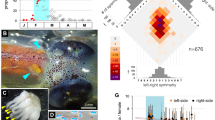Abstract
Dugesia sanchezi reproduces in nature both sexually and by fission. Laboratory cultures have shown that fissioning is controlled by genetic factors. From sexual specimens randomly mated, 105 sexual and five fissiparous offspring were obtained. The former produced almost exclusively sexual descendents while the latter gave rise to fissiparous individuals, although successively many of them became sexual. These ex-fissiparous specimens show a high fertility and their offspring were almost all fissiparous, with the same characteristics displayed by the preceeding fissiparous generation. Some hypotheses are advanced in order to attempt a genetical interpretation of these results.
Similar content being viewed by others
References
Benazzi, M., 1974. Fissioning in planarians from a genetic standpoint. In: Eds., Riser, N. W. & Morse, M. P., Biology of Turbellaria. New York: McGraw-Hill, pp. 476–492.
Benazzi, M., 1978. Karyological and genetic data on the planarian Dugesia sanchezi from Chile. Rd. Acc. Naz. Lincei, Ser. 8, 64: 299–301.
Benazzi, M. & Benazzi Lentati, G., 1976. Platyhelminthes. In: Ed. John, B., Animal Cytogenetics. Borntraeger, Berlin-Stuttgart, p. 1–182.
Hyman, L. H., 1959. On two fresh-water planarians from Chile. Am. Mus. Novit. No. 1932: 1–11.
Author information
Authors and Affiliations
Rights and permissions
About this article
Cite this article
Benazzi, M. Reproductive biology of Dugesia sanchezi, a fresh-water planarian from Chile. Hydrobiologia 84, 163–165 (1981). https://doi.org/10.1007/BF00026175
Issue Date:
DOI: https://doi.org/10.1007/BF00026175




